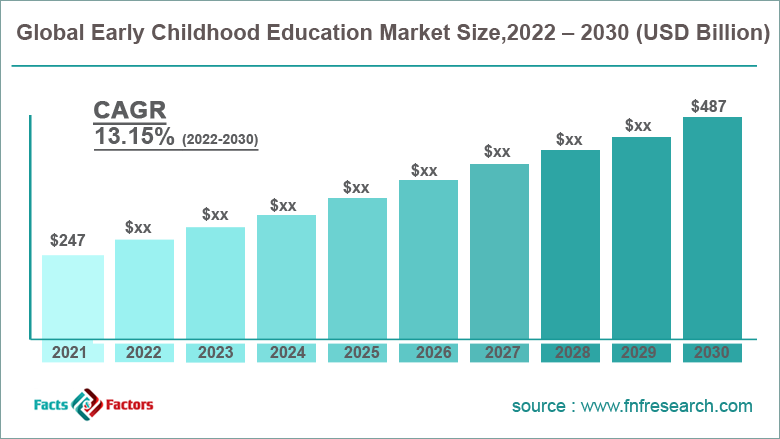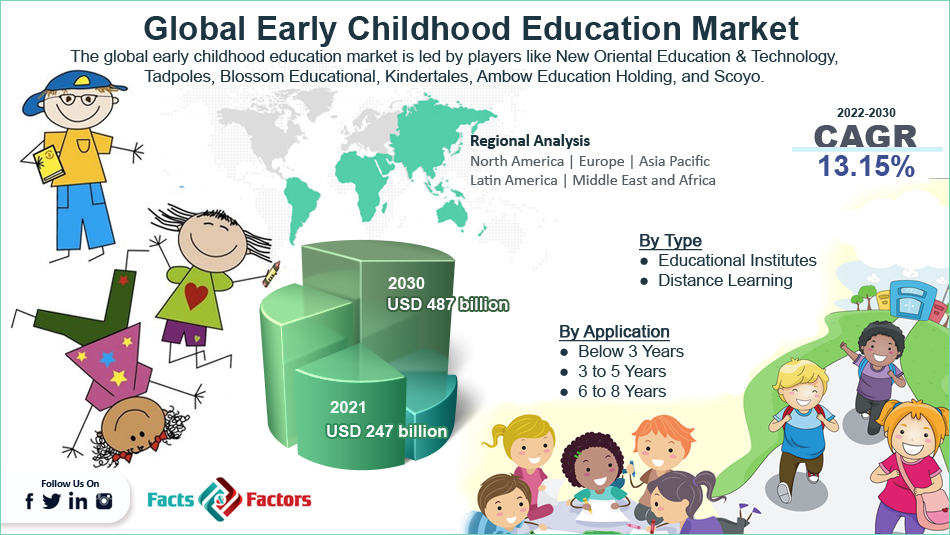Search Market Research Report
Early Childhood Education Market Size, Share Global Analysis Report, 2022 – 2030

Early Childhood Education Market Size, Share, Growth Analysis Report By Application (Below 3 Years, 3 to 5 Years, and 6 to 8 Years), By Type (Educational Institutes and Distance Learning), and By Region - Global and Regional Industry Insights, Overview, Comprehensive Analysis, Trends, Statistical Research, Market Intelligence, Historical Data and Forecast 2022 – 2030
Industry Insights
[232+ Pages Report] According to the report published by Facts and Factors, the global early childhood education market size was worth around USD 247 billion in 2021 and is predicted to grow to around USD 487 billion by 2030 with a compound annual growth rate (CAGR) of roughly 13.15% between 2022 and 2030. The report analyzes the global early childhood education market drivers, restraints/challenges, and the effect they have on the demands during the projection period. In addition, the report explores emerging opportunities in the early childhood education market.

 Market Overview
Market Overview
Early childhood education (ECE) is also known as nursery education in many parts of the world and it refers to the brand of technology that deals with the education of young children from birth up to the age of 8 years. It includes both formal and informal teachings. In traditional terms, ECE teachings are equivalent to education classes up to the third grade. Quality of early childhood education is an integral and important part of child development which helps in shaping the child’s character and qualities.
Various studies have concluded the importance of ECE in terms of a child’s success in the later years of life since it not only caters to the educational well-being of a child but has an impact on overall personality growth including self-confidence, emotional, and mental health. Reports claim that children who have access to formal early childhood education generally tend to have a higher intelligence quotient (IQ) as compared to children who are deprived of it.
 Key Insights
Key Insights
- As per the analysis shared by our research analyst, the global early childhood education market is estimated to grow annually at a CAGR of around 13.15% over the forecast period (2022-2030)
- In terms of revenue, the global early childhood education market size was valued at around USD 247 billion in 2021 and is projected to reach USD 487 billion, by 2030.
- The market is projected to grow at a significant rate due to the growing international and domestic level efforts to provide quality education
- Based on application segmentation, 6 to 8 years was predicted to show maximum market share in the year 2021
- Based on type segmentation, educational institutes was the leading type in 2021
- On the basis of region, North America was the leading revenue generator in 2021

 Growth Drivers
Growth Drivers
- Growing international and domestic level efforts to provide quality education may drive market growth
The global early childhood education market is projected to grow due to several factors but one of the major focus points is the growing emphasis at an international and domestic or regional level on early childhood education. These efforts are more evident in the undeveloped economies of the world where the citizens lack access to education infrastructure.
For instance, the United Nations Educational, Scientific and Cultural Organization (UNESCO), a specialized United Nations (UN) agency, provides leadership in education as well as helps in strengthening education systems across the globe. Due to the impact of Covid-19, the agency initiated a program focusing on education across Africa where it distributed interactive electronic books, animated learning videos, coloring electronic sheets, and learning games in different languages.
 Restraints
Restraints
- Lack of access to quality care to restrict market expansion
One of the most crucial aspects that currently dominates not only the early childhood education systems but the education industry, in general, is the lack of encouraging education infrastructure in many parts of the world. Underdeveloped economies with low family incomes that tend to have larger families cannot afford to spend on early childhood education for every child because of various social or financial reasons. There are numerous recorded incidents of female infants being denied access to quality care in early childhood. As per UNICEF Afghanistan, more than 3.7 million children are out of school out of which almost 60% are female students.
 Opportunities
Opportunities
- Growing number of players to provide growth opportunities
The global early childhood education market is expected to witness higher growth opportunities due to the growing number of players in the market. Until a few years ago, fewer institutes offered quality formal or informal education to children below 3 years of age. Since the number was limited the cost was high.
However, in recent times, as the working population is growing and there is significant demand for early childhood as both parents start resuming work a few months after the child is born, many players have grabbed the opportunity and created a chain of institutes offering nursery care. As the population grows, the demand for such institutes is expected to reach new heights.
 Challenges
Challenges
- Remote working culture to act as a challenge
The global market growth may face growth challenges due to the increasing remote working culture in which parents can work from home using a hybrid model giving them more time to spend at home. The parents prefer to indulge in learning and educational sessions at home rather than sending children to outside institutes. There is also a growing segment of the population that prefers homeschooling children since they find it more helpful as children gain practical knowledge.
 Segmentation Analysis
Segmentation Analysis
The global early childhood education market is segmented based on application, type, and region.
In 2021, the highest revenue-generating segment was the 6 to 8 years segment which dominated more than 42.59% of the global market share. Children falling in this age group are highly impressionable and are also capable of understanding new techniques for learning new subjects and lessons. They can adapt to a new life far more quickly and with relatives as compared to younger children.
Parents feel safer sending children between the age of 5 to 8 years to school since they can communicate well. Guardians or parents of children below 3 years may get reluctant in sending the children to school. 8% of the world’s children in the primary school age group do not go to school.
The former led the global market growth in 2021 due to the high number of parents sending students to schools as the main goal of ECE is personality development which can be achieved more effectively in face-to-face and interactive learning sessions. Distance learning gained more popularity as a result of Covid-19 and will continue the growth rate if it can meet the efficiency of offline classes. In a 2020 report, more than 50% of parents preferred to send children to school instead of online classes.
 Recent Developments:
Recent Developments:
- In January 2023, India's Union Education Ministry announced that it will be introducing a new curriculum for classes from pre-primary to class 2 and the new program will be brought into action on 26th January 2023. The new framework is as per the New Education Policy 2020 and includes educational textbooks in Indian languages.
- In August 2022, Reliance Foundation, one of India’s largest non-profit organizations, announced that it will be inaugurating a new school with the primary goal to spread awareness about early childhood education and care in the country. The move perfectly aligns with the organization’s goal to create opportunities for the underprivileged in India
 Report Scope
Report Scope
Report Attribute |
Details |
Market Size in 2021 |
USD 247 Billion |
Projected Market Size in 2030 |
USD 487 Billion |
CAGR Growth Rate |
13.15% CAGR |
Base Year |
2021 |
Forecast Years |
2022-2030 |
Key Market Players |
New Oriental Education & Technology, Tadpoles, Blossom Educational, Kindertales, Ambow Education Holding, Scoyo., and others. |
Key Segment |
By Application, Type, and Region |
Major Regions Covered |
North America, Europe, Asia Pacific, Latin America, and the Middle East &, Africa |
Purchase Options |
Request customized purchase options to meet your research needs. Explore purchase options |
 Regional Analysis
Regional Analysis
- North America to lead with the highest CAGR during the forecast period
The global early childhood education market is projected to register the highest growth in North America due to the higher accessibility as the US and Canada are amongst the top-ranking regions in terms of quality education across age groups. The population of these countries has relatively higher per-capita income which allows them to spend on education programs which is further encouraged by the government’s efforts in establishing an educational ecosystem where every child from all family income groups has equal opportunities for gaining quality education.
The parents in these advanced countries have a higher understanding of the benefits of early childcare and education which encourages them to enroll young children in institutes that can help the child develop social skills while contributing to the overall development.
 Competitive Analysis
Competitive Analysis
- New Oriental Education Technology
- Tadpoles
- Blossom Educational
- Kindertales
- Ambow Education Holding
- Scoyo
The global early childhood education market is segmented as follows:
 By Application Segment Analysis
By Application Segment Analysis
- Below 3 Years
- 3 to 5 Years
- 6 to 8 Years
 By Type Segment Analysis
By Type Segment Analysis
- Educational Institutes
- Distance Learning
 By Regional Segment Analysis
By Regional Segment Analysis
- North America
- The U.S.
- Canada
- Mexico
- Europe
- France
- The UK
- Spain
- Germany
- Italy
- Nordic Countries
- Denmark
- Sweden
- Norway
- Benelux Union
- Belgium
- The Netherlands
- Luxembourg
- Rest of Europe
- Asia Pacific
- China
- Japan
- India
- Australia
- South Korea
- Southeast Asia
- Indonesia
- Thailand
- Malaysia
- Singapore
- Rest of Southeast Asia
- Rest of Asia Pacific
- The Middle East & Africa
- Saudi Arabia
- UAE
- Egypt
- South Africa
- Rest of the Middle East & Africa
- Latin America
- Brazil
- Argentina
- Rest of Latin America
Industry Major Market Players
- New Oriental Education & Technology
- Tadpoles
- Blossom Educational
- Kindertales
- Ambow Education Holding
- Scoyo

Copyright © 2025 - 2026, All Rights Reserved, Facts and Factors


